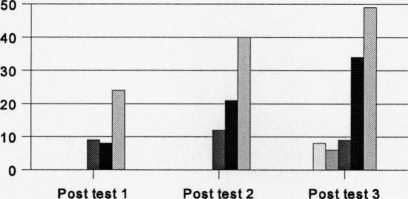Statistical analysis revealed that the children tended to provide more “perceptual”
justifications for the words describing animals than for the words describing artifacts.
Significant differences were found during post test 3 (t=2.27, df=129, p<.05).The same
analysis was repeated separately for each group. The same pattern was found for all the
groups, however the differences were not significant.
Analysis of the Semantic justifications
Is there a differential impact of the type of exposure to new lexical items that the children
receive on the provisionofsemantic justifications?
Figure 7.22 shows that the Lexical contrast and Definition groups provided more “semantic”
justifications across testing. Nevertheless, the Definition group provided more “semantic”
justifications than the other groups across testing. On the other hand, the Control,
Phonological control and Ostensive definition groups did not provide as many “semantic”
justifications.
Figure 7.22 Provision of semantic justifications in the association task by group across
testing

I I Control
[-~1 Phonological Control
■ Ostenaive definition
l=J.∣ Lexical contrast
[ I Definition
Three One Way Analyses of Variance were carried out to test differences by group. Each
time, group was the independent variable and score in the “semantic” justifications was the
dependent variable. The Definition group provided significantly more “semantic”
justifications than the Lexical contrast group (Wilcoxon: Pl: Z=1.9, p<.05; P2: Z=2.5, p<.05)
as well as more “semantic” justifications than the Ostensive definition group during post test
2 (Wilcoxon: Z=3.7, p<.0005). During post test 3, the Definition and Lexical contrast groups
provided significantly more “semantic” justifications than the Control group (Wilcoxon:
243
More intriguing information
1. Implementation of the Ordinal Shapley Value for a three-agent economy2. IMMIGRATION POLICY AND THE AGRICULTURAL LABOR MARKET: THE EFFECT ON JOB DURATION
3. Female Empowerment: Impact of a Commitment Savings Product in the Philippines
4. Proceedings of the Fourth International Workshop on Epigenetic Robotics
5. The name is absent
6. Towards Learning Affective Body Gesture
7. CROSS-COMMODITY PERSPECTIVE ON CONTRACTING: EVIDENCE FROM MISSISSIPPI
8. Innovation in commercialization of pelagic fish: the example of "Srdela Snack" Franchise
9. Inhimillinen pääoma ja palkat Suomessa: Paluu perusmalliin
10. Global Excess Liquidity and House Prices - A VAR Analysis for OECD Countries